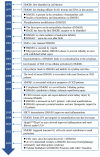Targeting HMGB1: A Potential Therapeutic Strategy for Chronic Kidney Disease
- PMID: 37781525
- PMCID: PMC10539693
- DOI: 10.7150/ijbs.87964
Targeting HMGB1: A Potential Therapeutic Strategy for Chronic Kidney Disease
Abstract
High-mobility group protein box 1 (HMGB1) is a member of a highly conserved high-mobility group protein present in all cell types. HMGB1 plays multiple roles both inside and outside the cell, depending on its subcellular localization, context, and post-translational modifications. HMGB1 is also associated with the progression of various diseases. Particularly, HMGB1 plays a critical role in CKD progression and prognosis. HMGB1 participates in multiple key events in CKD progression by activating downstream signals, including renal inflammation, the onset of persistent fibrosis, renal aging, AKI-to-CKD transition, and important cardiovascular complications. More importantly, HMGB1 plays a distinct role in the chronic pathophysiology of kidney disease, which differs from that in acute lesions. This review describes the regulatory role of HMGB1 in renal homeostasis and summarizes how HMGB1 affects CKD progression and prognosis. Finally, some promising therapeutic strategies for the targeted inhibition of HMGB1 in improving CKD are summarized. Although the application of HMGB1 as a therapeutic target in CKD faces some challenges, a more in-depth understanding of the intracellular and extracellular regulatory mechanisms of HMGB1 that underly the occurrence and progression of CKD might render HMGB1 an attractive therapeutic target for CKD.
Keywords: AKI-to-CKD transition; CKD; HMGB1; renal homeostasis; therapeutic strategy.
© The author(s).
Conflict of interest statement
Competing Interests: The authors have declared that no competing interest exists.
Figures





References
-
- Ruiz-Ortega M, Rayego-Mateos S, Lamas S, Ortiz A, Rodrigues-Diez RR. Targeting the progression of chronic kidney disease. Nature reviews Nephrology. 2020;16:269–88. - PubMed
-
- KDIGO 2020 Clinical Practice Guideline for Diabetes Management in Chronic Kidney Disease. Kidney international. 2020; 98: S1-s115. - PubMed
-
- Lameire NH, Levin A, Kellum JA, Cheung M, Jadoul M, Winkelmayer WC. et al. Harmonizing acute and chronic kidney disease definition and classification: report of a Kidney Disease: Improving Global Outcomes (KDIGO) Consensus Conference. Kidney international. 2021;100:516–26. - PubMed
-
- Luo S, Grams ME. Epidemiology research to foster improvement in chronic kidney disease care. Kidney international. 2020;97:477–86. - PubMed
-
- Tang D, Kang R, Zeh HJ, Lotze MT. The multifunctional protein HMGB1: 50 years of discovery. Nature reviews Immunology. 2023. - PubMed
Publication types
MeSH terms
Substances
LinkOut - more resources
Full Text Sources
Medical

